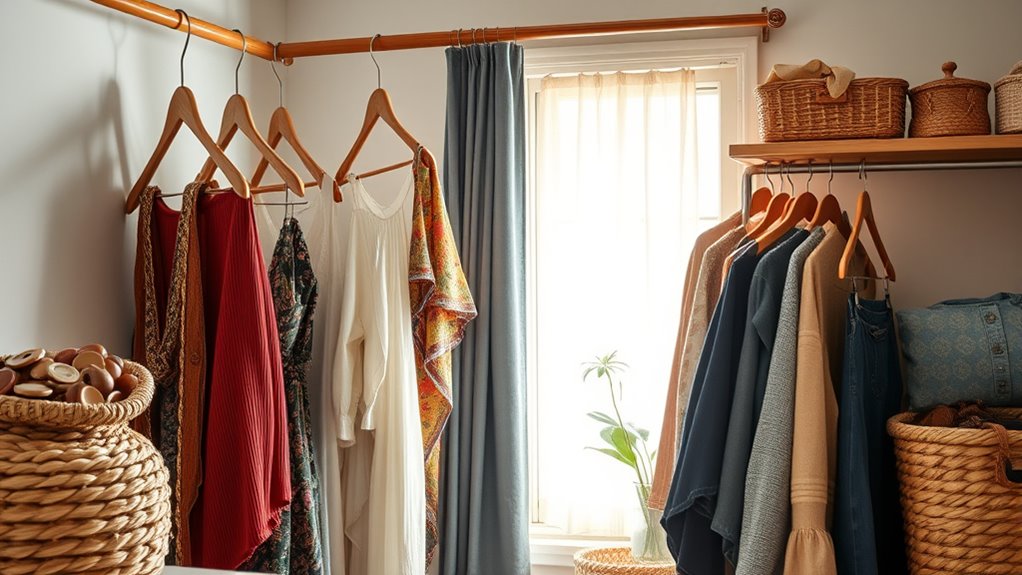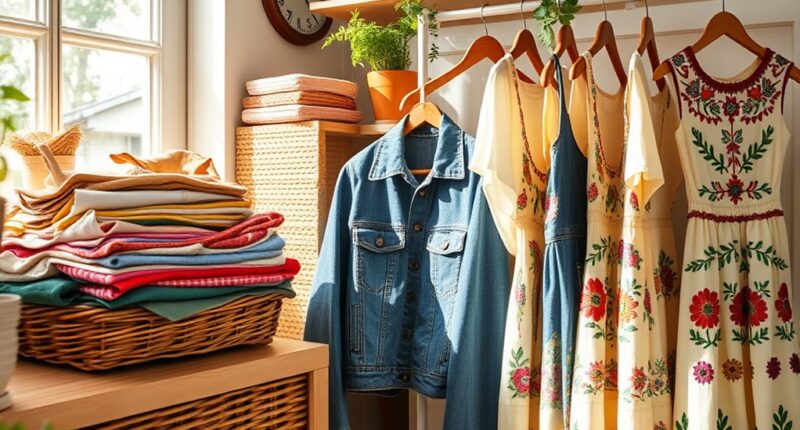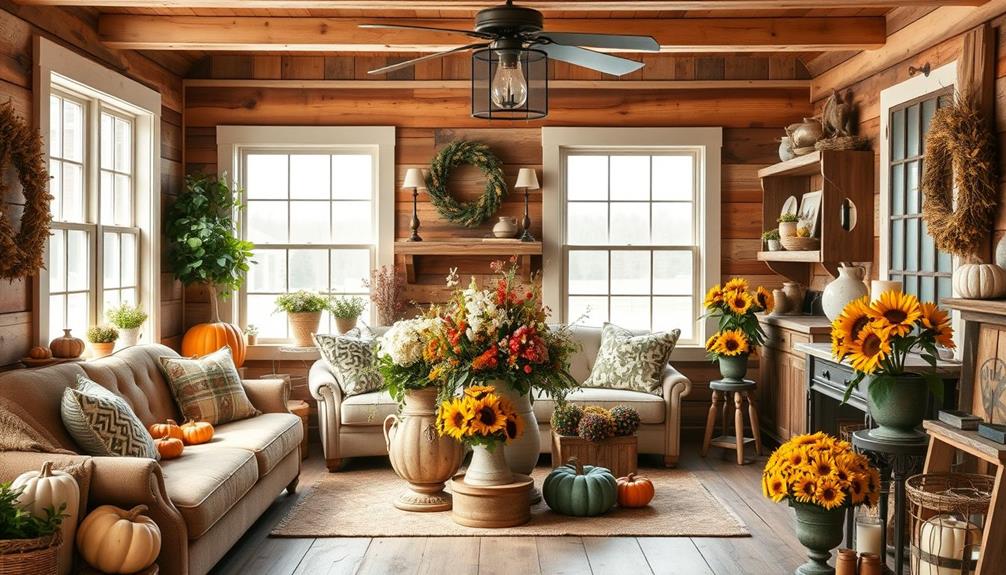To embrace zero-waste fashion, choose clothing made from sustainable fabrics like organic cotton, hemp, or recycled fibers to reduce environmental impact and guarantee durability. Repair your garments with DIY fixes for tears and stains to extend their life, preventing waste and saving resources. Focus on supporting ethical brands and selecting versatile pieces that can be styled differently. These simple hacks help you minimize waste and create an eco-friendly wardrobe—stay with us to discover more sustainable tips.
Key Takeaways
- Opt for versatile, high-quality clothing pieces that can be mixed and matched to maximize outfit options and reduce overconsumption.
- Repair and upcycle existing garments through DIY techniques to extend their lifespan and avoid unnecessary waste.
- Choose sustainable fabrics like organic cotton, hemp, or recycled fibers to minimize environmental impact and promote durability.
- Support ethical brands committed to eco-friendly practices, ensuring your wardrobe aligns with zero-waste principles.
- Practice mindful shopping by assessing your current wardrobe needs and avoiding impulsive purchases, fostering a more sustainable closet.

Ever wonder how you can stay stylish while reducing waste? One of the simplest ways is by making mindful choices when it comes to your wardrobe. Embracing sustainable fabric choices allows you to select clothing made from eco-friendly materials like organic cotton, hemp, or recycled fibers. These fabrics not only lessen your environmental impact but often last longer, reducing the need to replace items frequently. When shopping, look for brands committed to sustainable practices and prioritize quality over quantity. This way, your closet is filled with versatile pieces that stand the test of time, minimizing the cycle of fast fashion waste.
Beyond choosing eco-friendly fabrics, another effective zero-waste fashion hack is mastering DIY clothing repairs. Instead of tossing out a ripped seam or a stained shirt, learn simple repair techniques like sewing on patches, replacing missing buttons, or fixing small tears. Repairing your clothes extends their lifespan and keeps your wardrobe fresh without purchasing new items. Plus, it’s a satisfying way to personalize your pieces and develop your sewing skills. You don’t need to be a professional tailor; basic stitches can make a big difference. Keep a small repair kit handy with needles, thread, and scissors to patch up clothes as needed. Not only does this reduce textile waste, but it also encourages a more sustainable mindset, making you more conscious of your consumption habits.
Incorporating sustainable fabric choices and DIY clothing repairs into your routine requires a bit of effort upfront, but it pays off in the long run. When you opt for sustainable fabrics, you support brands that prioritize ethical production and eco-friendliness, which helps reduce the environmental burden of the fashion industry. Meanwhile, practicing DIY repairs keeps your clothing in use longer, cutting down on landfill waste and unnecessary purchases. Over time, these habits become second nature, transforming your closet into a more eco-conscious space. Plus, you might find that repairing and caring for your clothes becomes a fun, creative activity rather than a chore.
Frequently Asked Questions
How Can I Identify Truly Sustainable Fashion Brands?
To identify truly sustainable fashion brands, look for certifications like Fair Trade, GOTS, or B Corp, which verify ethical manufacturing and environmental practices. Research the brand’s transparency about sourcing, labor conditions, and materials. Brands committed to sustainability openly share their supply chain info and prioritize eco-friendly fabrics. Trust those with clear values and certifications, ensuring they genuinely reduce environmental impact and uphold ethical standards in every step of their production.
What Are Eco-Friendly Alternatives to Fast Fashion?
Think of choosing eco-friendly options as planting seeds for a greener future. You can opt for brands that use recycled fabrics and prioritize ethical sourcing, reducing environmental impact. These alternatives to fast fashion help you stay stylish while supporting sustainability. By making conscious choices, you’re not just wearing clothes—you’re nurturing a healthier planet for generations to come. It’s a simple switch that creates a ripple effect of positive change.
How Do I Care for Zero-Waste Clothing?
To care for zero-waste clothing, you should focus on proper fabric maintenance and stain removal. Always follow the care labels, wash clothes in cold water to conserve energy, and use eco-friendly detergents. For stain removal, gently treat spots with natural solutions like baking soda or vinegar before washing. Avoid tumble drying to prolong your garments’ life, and consider air drying to reduce waste and keep your clothes looking their best.
Can Zero-Waste Fashion Be Affordable?
Yes, zero-waste fashion can be affordable if you focus on cost-effective fabrics like organic cotton or Tencel. Using budget shopping tips, you can find stylish, sustainable pieces without overspending. Look for thrift stores, sales, or online marketplaces to snag unique items at lower prices. By prioritizing versatile, durable fabrics and smart shopping, you make zero-waste fashion accessible and budget-friendly for your wardrobe.
Where Can I Find Tutorials for DIY Upcycling Projects?
If you’re looking for tutorials for DIY upcycling projects, you’re in luck. You can find a wealth of resources online, especially on platforms like YouTube, where sewing tutorials and upcycling techniques are abundant. Search for specific projects or techniques, and you’ll discover step-by-step guides to transform old clothes into stylish new pieces. These tutorials make it easy to learn and get creative with your wardrobe upgrades.
Conclusion
Think of your closet as a lush garden, where every piece of clothing is a blooming flower. By embracing these zero-waste hacks, you’re tending to your garden with care, ensuring each bloom thrives without waste. With mindful choices, your wardrobe becomes a vibrant, sustainable landscape—blooming beautifully today and for generations to come. So, nurture your fashion garden, and watch it flourish into a stunning, eco-friendly paradise.









